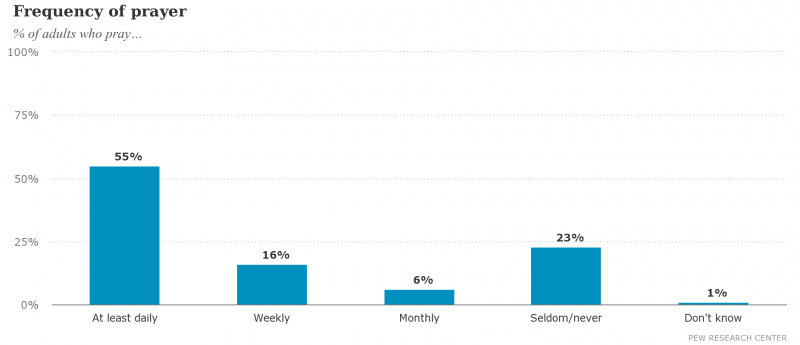Imagine being surrounded by enthusiasm for holidays, foods, and traditions that hold no significance to you.
This is the everyday reality for many of our non-Christian students. From Christmas parties to Easter egg hunts and even biblical quotes, most campuses are saturated with things that — whether they mean to or not — exclude religious minority students.
Most of these students don’t want to rain on Christians’ parade or be a scrooge (to borrow a Christian phrase). But not being invited to the party or having your absence go unnoticed can be frustrating.
Many religious minority students are bursting with pride for their own religion and want to express their beliefs, share their values, and showcase their traditions, too. But since most institutions are set up to primarily center Christianity, non-Christian students may struggle to find religious resources and a sense of religious community.
How can we help religious minority students feel seen, understood, and celebrated on campus? How can we ensure that they feel fully part of our institutions’ diverse religious spectrum, rather than tokenized representatives of the “other”?
Well, here are seven of my top suggestions — curated from research by colleagues, and informed by my own experiences as a Jewish student and as a professional with Hillel, a Jewish campus organization.
7 Supportive Practices
1. Avoid assumptions about background, beliefs, and practice
Just as we should never assume that all women have the same relationship with their gender or that all black students have the same connection to their race, we must avoid leaping to conclusions about someone based on their religion.
A student saying, “I’m Hindu,” for example, is not the same as them saying, “I grew up in a Hindu home, I observe all Hindu holidays, I know every Hindu tradition, and Hinduism is extremely important to me.” All, none, or just some of those latter statements may be true.
When I worked for Hillel, knowing that a student was Jewish didn’t mean I knew very much about them. I met Jewish students who strictly observed every holiday and Jewish students who barely heard of Chanukah. I got to know students who cherished fond memories of Jewish day school and overnight camp, along with students who hated being dragged to anything remotely Jewish by their families.
Among each of these backgrounds and behaviors, I found Jewish students who considered Judaism to be the chief marker of their identity and students who’d brush Judaism away, emphasizing that they’re only Jew-ish.
My point is: There’s immense variety within each religious community. Thus, even after hearing how a student self-identifies, we can’t make assumptions regarding how, precisely, they’d like to explore religion while in college. (They might not want to explore it at all.)
Keep this in mind when reading the other tips below.
2. Keep an eye on religious holidays
You most certainly wouldn’t schedule an unrelated event on Easter or Good Friday. But what about Eid al-Adha, Rosh Hashanah, or Diwali? For many Muslim, Jewish, and Hindu students, respectively, an event set on one of those days can be wildly inconvenient or even insulting.
Even if a student doesn’t personally observe that holiday, seeing advertisements and hearing hype for an event on a sacred day for their religion can feel isolating. It can seem like their institution doesn’t care about their religious customs — that their staff mentors and peer leaders view their religion as less important than the majority religion.
Less dramatically, (yet still offensively) it can demonstrate that the event planners didn’t bother to look up a broadly inclusive religious calendar.

So, avoid that. Keep a calendar. Drexel University has an extensive one, including holidays for over a dozen religions, as does the University of Washington and the University of Missouri. Spread it far and wide, for all students and staff to see and continually consult.
But avoid being too strict. Due to the sheer number of existing holidays, it may be impossible to craft a vibrant campus life while avoiding every single one. Certain minor holidays may be perfectly fine days for institutions and student organizations to throw an event. In Judaism, for example, the high holy day of Yom Kippur is a major no-no, but the celebratory holidays of Tu B’Av and Tu B’Shvat are a-okay.
How can you know the difference? Research online, consult with faculty of your religious studies department, ask campus chaplains, and talk to students. None of these folks will be able to tell you how every student feels about a particular holiday (remember the diversity within each religion I mentioned earlier?), but they can at least help you make a well-informed decision.
And beyond being useful for event scheduling, keeping a calendar of religious holidays can help you stay informed of what’s going on in your students’ lives. It can remind you to wish Jewish students “Happy Chanukah” or inquire about a Bahá’í student’s Naw-Rúz plans.
Though simple, such well wishes and questions could make students feel more welcome, cherished, and understood on campus — just as a simple “Happy Easter!” might brighten a Christian student’s day.
An important caveat: Be careful not to imply that every student must celebrate every holiday of their religion. Not all Muslims fast during the days of Ramadan, nor do all Jewish students pray throughout Kol Nidrei, for example. Assumptive statements, despite the innocence of your intentions, can make students feel like less valid members of their religion.
Instead, simply acknowledge that it is a holiday. And if you have a good rapport with the student, you can ask if they celebrate the day, rather than assuming how they do.
3. Avoid religious names for non-religious events
Your religious minority students likely love the school break during Christmastime as much as Christian students do. But, they probably think of it as Winter Break, not Christmas Break. And officially, your institution almost certainly calls it Winter Break, too. So, don’t wish them — individual students nor a group — a “wonderful Christmas Break.” Not everyone celebrates that.
This might seem like splitting hairs, as most students will know your good intentions no matter the name you use, but it’s not. Words matter. Over time, hearing wishes that don’t match with their religious experiences and cultural realities can make students feel isolated and othered.
An event called a “Christmas Party” or an “Easter Celebration” can have the same effect. Of course, if a party truly is focused on Christmas or Easter, go ahead and label it as such. But, if you’re looking to celebrate winter or spring more broadly — with non-religious activities or an interfaith mix of them — avoid frivolously giving it a Christian name. It’ll go a long way in letting students of all religions feel welcome.
4. Acknowledge religious hate crimes
In the immediate aftermath of a campus shooting, professionals at institutions worldwide tend to check in on their students and acknowledge their pain. Ditto local tragedies. But, do you remember to check in with students when religious hate crimes make the news?
Even if the news of a religious hate crime just seems like part of another somber day to you, it might be absolutely devastating to students of the targeted religion.
My Jewish students at the University of Pittsburgh certainly felt that way after the Tree of Life Synagogue shooting. It was earth-shattering — all they could think about for weeks. I also heard similar sentiments from other Jewish students nationwide, thousands of miles away from Pittsburgh.
When faculty members they trusted and staff mentors they looked up to failed to mention the shooting, it hurt. The Jewish community was in pain, and though most staff and faculty responded with great compassion, the few who acted like nothing had happened made students feel unseen and undervalued.
So, please acknowledge religious hate crimes — not just those that occur on or near your campus but worldwide. Let students know that in addition to condemning the crime and the hate that motivated it, you value them, you know they may be distressed, and you’re available to support them.
You can convey that message by personally checking in on students you’re close with and, when appropriate, directing students to counseling services or chaplains. You can also publicly express your disgust with the crime.
But don’t merely put out a clever Facebook post and call it a day; stay continuously attentive of student’s feelings and campus happenings.
5. Offer food that meets religious dietary requirements
You might be thinking that this tip is impossible to implement. You already spend so much money on food at events, how can you possibly afford to buy more items, particularly specialty ones?
Well, if you hope to engage students who adhere to religious dietary laws, you must. Seeing their peers chow down on pepperoni pizza or pork tacos, while the staff shrugs and offers a meek “sorry,” can’t be fun. You’ve just handed them a reason not to come back.
But don’t fret; I’m not suggesting that you need to offer a separate buffet of Kosher and Halal food. Rather, you should make your events inclusive of religious minority students in the same way that you hopefully already do for students who are vegan, gluten-free, lactose-intolerant, or have other dietary restrictions.
Work with your dining hall or seek out local restaurants to find appropriate food options. Have students build their own sandwiches or plates from a selection of ingredients, rather than only offering items premade with all the fixins. Have students tell you about their favorite spot nearby for Kosher or Halal food and bring in a meal for them.

Worse comes to absolute worst, let students know that you, unfortunately, couldn’t find an option for them but they’re welcome to bring in their own food. (And ideally, you’ll reimburse the cost.)
And always triple-check that the food is indeed Kosher and Halal. It’s not as simple as being devoid of certain ingredients. Food needs to be cooked and processed in particular ways in order to be granted Kosher and/or Halal certifications. Check with the restaurant or food vendor. Prepackaged foods will show certification symbols on their labels.
6. Offer spaces for meditation, yoga, and prayer
Prayer is a central component of many religious practices. 68% of Americans ages 18-29 pray at least once a month. So, not having a comfortable prayer space is an easy way to make many students feel unsupported or homesick.

No, sorry, a bed may not be an adequate spot. Residence halls, family homes, and apartment complexes are often too loud, and feel far from relaxing or spiritual. Students may yearn for a separate, calmer space.
Additionally, they may need more square feet. Many people prefer to pray in groups. Orthodox Judaism even requires it. And, many prayer practices involve wide body movements. Yoga is central to Hinduism, Buddhism, Sikhism, and Jainism. Some Sufi Muslims whirl, and some Native Americans regard dance as a form of prayer.
Perhaps you’re thinking that you can simply offer up a room in your campus’s chapel, church, or cathedral. That’s a nice thought (truly), but many religious minority students may feel wary of entering — nevermind praying in — a space that’s specifically called a chapel, church, or cathedral, given the Christian history of those terms.
The Interfaith Youth Core has some great ideas for crafting a space that’s truly inclusive of all religions. It highlights Union College, Elizabethtown College, and Elon University, which all created welcoming interfaith “sacred spaces” based on diverse student input. Keys to their success include movable furniture, shelves for sacred texts and prayer rugs, minimal decoration, and a central location.
7. Educate yourself on religious campus resources and traditions
Students shouldn’t expect any one campus professional to be a definitive expert on every campus service. Nor should they expect us to be connoisseurs of every world religion. But, we should at least be able to direct students toward fitting resources.
This means you should keep yourself abreast of religious campus organizations, traditions, spaces, and opportunities. Students shouldn’t have to speak with a Jewish professional to find out where Hillel is located, for example, nor run into a Muslim advisor to learn if their institution has a Muslim Student Association.
All professionals should learn the basics of what their campus and local community have to offer — even if that just means directing students to the right chaplain (who can advise students further).
To embrace religious minority students even more, I suggest learning about holiday celebrations. Remember that holiday calendar you surely made after reading my earlier tip? Next, find out how students can celebrate those days on campus or nearby. Write in the time and location of a student org’s Holi bonfire or a local synagogue’s Passover Seder. Perhaps your campus’s interfaith or multicultural center assembles a yearly calendar you can utilize.
What have you done to demonstrate your full embrace of religious minority students on campus? What lingering questions do you have regarding best practices? Tweet us @themoderncampus.





